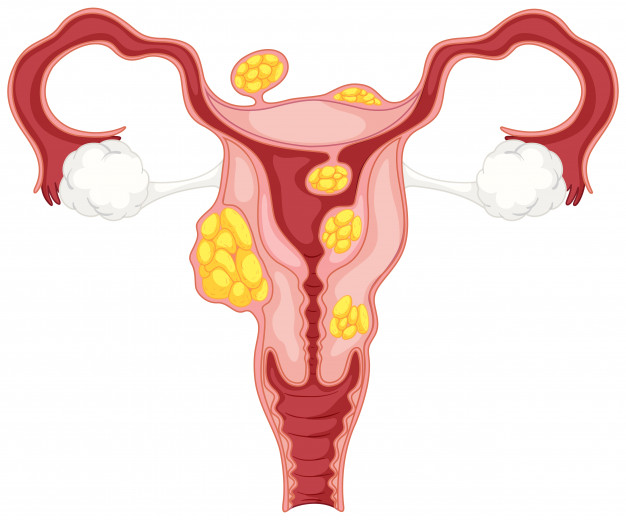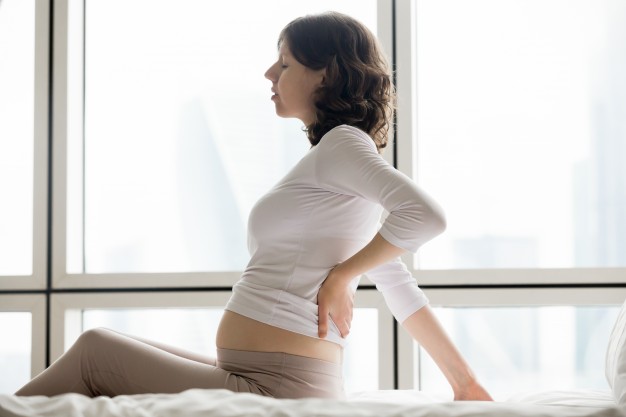Fibroids
Fibroids:
It is a condition of growth of muscles in the uterus. It is not cancerous.
They can be different in sizes, and it can be one or multiple.
They mostly develop during reproductive years (around age of 16 – 50).
Cancerous fibroids occur very rarely if ever. and some doctors believe that cancerous fibroids do not develop from already existing ones.
Symptoms:
Many women do not know that they have fibroids as they may show no symptoms.
If symptomatic, it might include:
1. Heavy period, most common
2. prolonged period
3. Urinary tract or bowel pressure symptoms such as:
a. Frequent urination
b. Difficulty in emptying the bladder
c. Constipation
d. Hydronephrosis with large fibroids
4. Painful intercourse
5. Infertility
6. Backache or leg pain
Risk factors:
1. African ethnicity.
2. Early menstruation (<10 years old)
3. Early exposure to hormonal contraceptives (13 to 16 years old)
4. Significant consumption of beef and other reds meats
5. Vitamin D deficiency
6. Obesity
Types:
Based on its location:
1. Intramural fibroids: grow within the uterine wall.
2. Submucosal fibroids: bulge into the uterine cavity
3. Subserosal fibroids: outside of the uterus
4. Cervical fibroids: located in the cervix
Causes:
Causes are unknown, but it might be associated with hormones imbalance (too much estrogen), or it might be genetic.
Diagnosis:
As they are asymptomatic in some cases, they are accidentally discovered during a regular pelvic test where the uterus is enlarged or has an irregular shape.
1. Physical bimanual examination for the abdomen.
2. Lab tests for anemia and thyroid hormones in case of long-term heavy period or prolonged period, to rule out thyroids diseases.
3. Pelvic ultrasound test is done to confirm the existence of fibroids.
4. Renal ultrasound if fibroids were suspected to cause urinary tract obstruction.
5. Sonohysterography to identify submucosal and intramural fibroids.
6. MRI: to identify the size and location of fibroids.
Treatment:
It is not necessary to treat fibroids as they might be asymptomatic or with mild symptoms that not affecting quality of life.
Fibroids often shrink after menopause.
1. Treating heavy period medications.
a. IUD, releasing progestin hormone:
It does not shrink or remove the fibroids, but helps in reducing heavy bleeding.
b. NSAIDs:
Taken only during period to relieve pain.
It does not remove fibroids.
It can relieve cramps but less effective in reducing bleeding.
c. oral contraceptives :
They reduce bleeding but do not reduce the size of fibroids.
d. Ulipristal acetate
It is a hormonal contraceptive.
Helps in reducing fibroids size and menstrual bleeding.
e. (GnRH) agonists
injection given once every one to three months
Works by blocking the production of estrogen and progesterone, causing a temporary menopause, to make fibroids shrink.
It can cause hot flashes.
Not used for more than 3 – 6 months as long term use may cause bone loss.
They might be used before surgery, to shrink them and making it easier to be removed.
f. Tranexamic acid:
do not contain hormones.
Works by helping blood to clot which reduce bleeding.
taken only during period.
do not shrink fibroids.
It is advised not to be taken with birth control pills due to the risk of stroke and blood clots.
2. Surgery:
a. Myomectomy: removing fibroids.
It is advised to wait for three months after this surgery before trying getting pregnant.
Risk of fibroids coming back after myomectomy: (10% and 25%)
Can be performed in different ways:
– Abdominal: incision in the lower abdomen
– Hysteroscopic: by inserting instruments through the cervix, if the fibroids are located inside the uterus.
– Laparoscopic: several incisions in the abdomen.
Fibroids are broken into smaller pieces (morcellation)
b. Endometrial ablation:
Destroying the lining of your uterus
Does not remove fibroids, but helps in treating heavy bleeding.
Pregnancy is not possible or carries high risk of complications after the surgery.
c. Hysterectomy
other options have failed ,and the woman has no desire for future children.
Pregnancy is not possible after the surgery.
3. Non-surgical:
a. Uterine artery embolization: block blood supply to fibroids which will cause the fibroids to shrink.
Fertility may get effected after this procedure.
b. MRI guided focused ultrasound surgery:
Requires no incision. After identifying the location of fibroids, using ultrasound waves energy through the abdominal wall to destroy the fibroids.
After identifying the location of fibroids, using ultrasound waves energy through the abdominal wall to destroy the fibroids.
This might not be the best option if trying to optimize future fertility.
Surgical treatment options and pregnancy:
All risks and benefits of all surgical treatments should be discussed first with the doctor.
If the woman wants to preserve her fertility, myomectomy is the option, as the others have some risks.
Prevention:
Healthy lifestyle by maintaining healthy weight and healthy diet of fruits and vegetables, getting enough vitamin D may help in reducing the risk of developing fibroids.
Complications:
Fibroids are usually not dangerous, but they may cause:
1. Miscarriage, Rare.
2. Preterm delivery.
3. Cesarean delivery.
4. Placenta abruption.
5. Infertility.
6. Anemia due to heavy blood loss.
7. Pressure on the stomach leading to digesting problems due to the large size of the fibroid.
8. Pressure on the ureters due to the large size of the fibroid.



